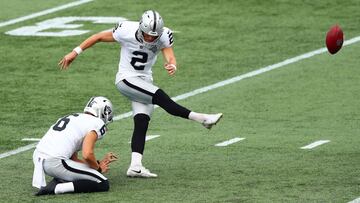NFL kickoff rule change: What advantage did the Raiders have?
A little-known, and thoroughly unremarkable kickoff rule has been re-interpreted by the NFL this week, to remove a play from the Raiders’ arsenal

The kickoff in football is one of the least-regarded plays in the game, basically used only as a mechanism for putting the ball in play.
For the past few decades, the NFL has been toying with the idea of getting rid of the kickoff entirely. As perhaps the only play remaining in the game which has a strong element of chaos built into its very DNA, the league has moved the ball forward five yards and waived the “live” status of the ball in the end zone, encouraging more touchbacks than ever.
What are the Raiders up to?
Daniel Carlson is a great kicker and is able to get marvellous hang-time on his kicks, often rivalling the hang-time of many punters. With the ball sitting in the tee, however, it is very difficult for him to get under the ball. The solution? Put the ball on top of the tee, rather than sitting inside it.
The ball will only stand on its own when it is sitting inside the tee, so by placing the ball on the tee rather than in it, they needed to use a holder to steady the football.
Coach Josh McDaniels said that the Raiders then approached the league to clarify the rule. For the record, the exact text of the NFL rule is as follows:
Article 1. Free Kick
A free kick is a kickoff or safety kick that puts the ball in play to start a free kick down. It must be made from any point on the kicking (offensive) team’s restraining line and between the inbounds lines.
1. A kickoff puts the ball in play at the start of each half, after a try, and after a successful field goal. A dropkick or placekick may be used for a kickoff.
Note: During a placekick on a kickoff, the kicking team may use a manufactured tee that is one inch in height and approved by the League. Once the ball has been placed on the kicking tee, the kicking tee cannot be moved. If the ball falls off the tee, or the tee is moved, the covering officials must stop play and restart the timing process without penalty to the kicking team. If the ball falls off the tee a second time during the same free kick down, the kicking team then must either use a player to hold the ball or must kick it off the ground. The ball may be placed on the ground leaning against the tee, provided the tee is in its normal upright position.
2. A safety kick puts the ball in play after a safety. A dropkick, placekick, or punt may be used for a safety kick. A tee cannot be used for a safety kick.
Did you note the wording which defines the ball as being placed “on the tee” rather than “in” the tee? So did the Raiders.
“They clarified a rule a couple weeks ago, that you’re permitted to hold the ball on the top of the tee now, so we’ve got a good kicker, you can add hang time to the kick, and I think you saw Daniel use that to our advantage,” McDaniels said. “That’s the rules. They clarified it a couple weeks ago. If it helps us gain some type of advantage, we’ll try to do that.”
Turns out the league has had a change of heart.
The NFL’s officiating department had a heart-to-heart with the competition committee, and have now determined that, the wording of the rule notwithstanding, footballs can only be placed “in” the tee and not “on” the tee.
The argument for kicking short
While the league may prefer to eliminate the kickoff, starting play from the 25-yard-line places the kicking team at a significant disadvantage. Very few kick returns make it out that far, regardless of where on the field the kick is taken.
With the vast majority of the kicks that are run back making it only to the 20 or 21 yard-line, the kicking team is encouraged, almost required by the spirit of competition, to try and force the return. Kicking short is the surest way to do this.
Do you have to use a tee during kickoffs?
While the punt is clearly the best kick for a kickoff, the rules actually do not allow it. Only a placekick or a dropkick may be used, with very few dropkicks taking place in the modern game. Doug Flutie was the last player to score from a dropkick in a game back in 2006, when he faked the two-point conversion and instead put the ball between the uprights for a PAT.
Most fans and coaches consider the dropkick an anachronism, with no place in the modern game, owing mainly to the redesign of the ball itself over the past 70 years as the main culprit. Efforts to make it more streamlined, with pointier ends, has improved throwing distance and accuracy but at the cost of losing predictability in the bounce.
While the NFL has removed the Raiders’ tee placement option, it is almost certain that they will fiddle with this rule in the near future, as they are wont to do. Perhaps the league will see sense and allow punts as a viable kickoff play. Or perhaps they will move the restraining line back to the 30 rather than the 35. I wouldn’t hold my breath for that one, though.
Maybe the league will eliminate the play altogether and simply restart play from the 25-yard line. What a shame that would be.
Of course, there exists just a slim outside chance that some bright spark will try his hand at the dropkick. I wouldn’t be surprised if the Raiders were looking at this option right now.






